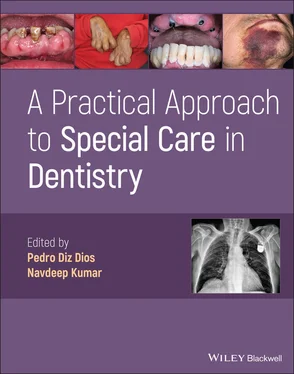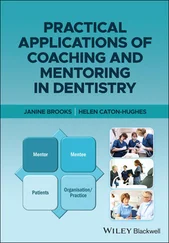A Practical Approach to Special Care in Dentistry
Здесь есть возможность читать онлайн «A Practical Approach to Special Care in Dentistry» — ознакомительный отрывок электронной книги совершенно бесплатно, а после прочтения отрывка купить полную версию. В некоторых случаях можно слушать аудио, скачать через торрент в формате fb2 и присутствует краткое содержание. Жанр: unrecognised, на английском языке. Описание произведения, (предисловие) а так же отзывы посетителей доступны на портале библиотеки ЛибКат.
- Название:A Practical Approach to Special Care in Dentistry
- Автор:
- Жанр:
- Год:неизвестен
- ISBN:нет данных
- Рейтинг книги:3 / 5. Голосов: 1
-
Избранное:Добавить в избранное
- Отзывы:
-
Ваша оценка:
- 60
- 1
- 2
- 3
- 4
- 5
A Practical Approach to Special Care in Dentistry: краткое содержание, описание и аннотация
Предлагаем к чтению аннотацию, описание, краткое содержание или предисловие (зависит от того, что написал сам автор книги «A Practical Approach to Special Care in Dentistry»). Если вы не нашли необходимую информацию о книге — напишите в комментариях, мы постараемся отыскать её.
Learn to treat dental patients with disabilities or who are medically compromised A Practical Approach to Special Care in Dentistry
A Practical Approach to Special Care in Dentistry
A Practical Approach to Special Care in Dentistry — читать онлайн ознакомительный отрывок
Ниже представлен текст книги, разбитый по страницам. Система сохранения места последней прочитанной страницы, позволяет с удобством читать онлайн бесплатно книгу «A Practical Approach to Special Care in Dentistry», без необходимости каждый раз заново искать на чём Вы остановились. Поставьте закладку, и сможете в любой момент перейти на страницу, на которой закончили чтение.
Интервал:
Закладка:
Diagnosis
HBVThe laboratory diagnosis of hepatitis B is based on detecting hepatitis B surface antigen (HBsAg) in a peripheral blood sampleIn the acute phase of the infection, immunoglobulin M (IgM) against the hepatitis core antigen (HBcAg) is also detectedThe presence of hepatitis antigen ‘e’ (HBeAg) is indicative of high levels of viral replication and therefore high infection potentialChronic hepatitis by HBV is characterised by the persistence of HBsAg for more than 6 months
HCVIn patients who have been infected by HCV, anti‐HCV antibodies are detected in serological testsTo confirm the chronic infection in patients who are anti‐HCV positive, a nucleic acid test for detecting HCV‐RNA is requiredWhen the HCV infection becomes chronic, biopsy and other less invasive tests are employed to quantify the hepatic damage
Management
HBVOnly 10–40% of patients with chronic hepatitis B require drug treatment, with tenofovir and entecavir the most widely used antiviral agentsIn most patients, the treatment suppresses viral replication but does not cure the hepatitisHBV can be prevented by vaccines that are safe, widely available and effective; these also provide protection from HDV infection.
HCVMore than 95% of patients with chronic hepatitis from HCV are cured with the administration of pangenotypic direct‐acting antivirals (DAAs)These are drug combinations that mainly include sofosbuvir, velpatasvir, voxilaprevir, glecaprevir and pibrentasvirThis has reduced deaths due to liver cirrhosis and hepatocellular carcinomaThere is currently no effective vaccine
Prognosis
HBVCauses 650 000 deaths annually as a result of the hepatic damage caused by viral hepatitisHBV infection becomes chronic in only 5% of infected adultsHowever, 20–30% of these develop cirrhosis or liver cancer
HCVCauses an estimated 400 000 deaths annuallyHCV infection becomes chronic in 70% of casesThe risk of cirrhosis and/or hepatocellular carcinoma within 20 years is estimated at 15–30%
A World/Transcultural View
Chronic viral hepatitis is especially frequent in low‐income countries, where transmission is typically mother to foetus or child to child (e.g. hepatitis B virus in Southeast Asia and sub‐Saharan Africa) or through contaminated blood (e.g. hepatitis C virus in Egypt, Pakistan and North Africa)
A significant number of countries, particularly African, still do not universally administer hepatitis B virus vaccine to infants
The success of a viral hepatitis detection programme depends on identifying target groups, whose beliefs and health perspectives can affect their acceptance
Although new treatment strategies for hepatitis C have demonstrated high rates of healing, they have created new inequalities in accessing treatment in low‐ to medium‐income countries
Recommended Reading
1 Averbukh, L.D. and Wu, G.Y. (2019). Highlights for dental care as a hepatitis C risk factor: a review of literature. J. Clin. Transl. Hepatol. 7: 346–351.
2 Castro Ferreiro, M., Diz Dios, P., and Scully, C. (2005). Transmission of hepatitis C virus by saliva? Oral Dis. 11: 230–235.
3 Carrozzo, M. (2014). Hepatitis C virus: a silent killer relevant to dentistry. Oral Dis. 20: 425–429.
4 Golla, K., Epstein, J.B., and Cabay, R.J. (2004). Liver disease: current perspectives on medical and dental management. Oral Surg. Oral Med. Oral Pathol. Oral Radiol. Endod. 98: 516–521.
5 Jefferies, M., Rauff, B., Rashid, H. et al. (2018). Update on global epidemiology of viral hepatitis and preventive strategies. World J. Clin. Cases 6: 589–599.
6 Klevens, R.M. and Moorman, A.C. (2013). Hepatitis C virus: an overview for dental health care providers. J. Am. Dent. Assoc. 144: 1340–1347.
7 Mahboobi, N., Porter, S.R., Karayiannis, P., and Alavian, S.M. (2013). Dental treatment as a risk factor for hepatitis B and C viral infection. A review of the recent literature. J. Gastrointestin. Liver Dis. 22: 79–86.
5 Endocrine Diseases 5.1 Diabetes Mellitus
Section I: Clinical Scenario and Dental Considerations
Clinical Scenario
An 11‐year‐old girl is referred by her paediatric endocrinologist for urgent management of dental pain. The pain commenced several days ago but has substantially worsened in the last 24 hours. It is localised to #54 which was treated by her family dentist 1 year ago.
Medical History
Type 1 diabetes mellitus, diagnosed at the age of 5 years old
Two episodes of severe hypoglycaemia in the last 12 months that required hospitalisation
Currently reviewed by her paediatric endocrinologist every 8 weeks
Coeliac disease diagnosed 6 months ago
Generalised anxiety (worsening)
Medications
Fast‐acting insulin
Long‐acting insulin (insulin glargine)
Strict diet control, including gluten‐free foods only for the last 6 months (supervised by her mother)
Dental History
Regular dental attender (biannual dental check‐ups since the age of 6 years)
Limited cooperation – sedation required when a filling was undertaken a year ago
Patient brushes her teeth with an electric toothbrush 3 times daily, usually supervised by her mother
Sporadically uses dental floss
Rinses with a fluoride mouthwash each night
Social History
Lives with her mother (divorced) during the weekdays and her father on the weekends
Her father is not as disciplined as her mother in relation to healthcare (e.g. diet control or tooth brushing)
Poor relationship between her parents contributing to increasing generalised anxiety for the patient
Oral Examination
Good oral hygiene
Buccal fistula adjacent to the carious #54 (disto‐occlusal filling in situ) – draining pus
Hypomineralisation of tooth #73
Two mouth ulcers on the right buccal mucosa (1 mm diameter)
Radiological Examination
Orthopantomogram undertaken ( Figure 5.1.1)
Delayed tooth eruption, with persistence of teeth #64, #74 and #84
Premature loss of tooth #83, due to eruption of #42
Structured Learning
1 Is there any connection with this patient's diagnosis of type 1 diabetes mellitus and coeliac disease?Type 1 diabetes mellitus is often associated with other autoimmune diseasesAlthough the most common coexisting organ‐specific autoimmune disease is autoimmune thyroid disease, coeliac disease may also be presentApproximately 8% of people with type 1 diabetes will also have coeliac diseaseCoeliac disease increases the risk of hypoglycaemia if a strict gluten‐free diet is not followed Figure 5.1.1 Panoramic radiography showing caries and a prior filling in tooth #54.
2 Why is a dental abscess of particular concern for this patient?Diabetes mellitus is known to be associated with increased risk of infection and impaired wound healing due to the chronic effects of hyperglycaemia:Neutrophil function (adherence, chemotaxis and phagocytosis) may be downregulated; neutrophils also produce fewer free oxygen radicals, thereby reducing their ability to make toxic metabolites for release against microbesMonocyte, macrophage and fibroblast functions are impaired, resulting in impaired tissue turnover and wound repairOral infection, pain and stress can result in alteration of blood glucose levels and lead to poor diabetic controlThe stress response elicited results in the release of hormones such as cortisol and adrenaline which work against the action of insulinAs a result, the body's production of glucose increases, which results in high blood sugar levelsAn insulin adjustment may be required
Читать дальшеИнтервал:
Закладка:
Похожие книги на «A Practical Approach to Special Care in Dentistry»
Представляем Вашему вниманию похожие книги на «A Practical Approach to Special Care in Dentistry» списком для выбора. Мы отобрали схожую по названию и смыслу литературу в надежде предоставить читателям больше вариантов отыскать новые, интересные, ещё непрочитанные произведения.
Обсуждение, отзывы о книге «A Practical Approach to Special Care in Dentistry» и просто собственные мнения читателей. Оставьте ваши комментарии, напишите, что Вы думаете о произведении, его смысле или главных героях. Укажите что конкретно понравилось, а что нет, и почему Вы так считаете.












